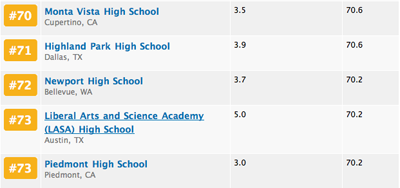
U.S. News & World Report, in its “Best High Schools” list released on Sept. 30, ranked MVHS as the seventieth best high school in the nation on its “Gold Medal List” and the second best open-enrollment school in math and science.
According to U.S. News, the holistic national rankings, which evaluated 21,786 schools across 48 states and the District of Columbia, were determined by a three-step process. Students’ reading and writing scores at each school were compared to the respective state’s statistically expected performance for the average student. The proportion of economically disadvantaged students enrolled in each school was taken into consideration, and the performance of each school’s least-advantaged students was similarly compared to the average disadvantaged students. The third step gauged the extent to which schools prepared their students for college by calculating a college readiness index, which consists of a school’s AP participation and pass rates, with the former weighted at 25 percent and the latter at 75.
Math and science rankings were calculated in a similar fashion: the same analysis of AP participation and pass rates was applied specifically to science, engineering, technology and math related courses, with math and science indexes each weighted 50 percent. In order to place on the math and science list, however, a school must have placed nationally overall by the report.
Principal April Scott values the U.S. News & World Report rankings as a validation of the school’s performance.
“It acknowledges the hard work that we do, and we would do it whether there was this measurement out there or not,” Scott said. “But, it’s nice to have an external measure that says ‘What you’re doing is working, and congratulations for doing a good job.’”
Although chemistry teacher Kavita Gupta also appreciates the validation provided by the rankings, she questions the report’s number-centric approach. Nonetheless, Scott believes that U.S. News & World Report’s methodology is more comprehensive than that of other publications in that it takes achievement gaps of minorities and disadvantaged students into account.
Both Scott and Gupta attribute the school’s high math and science ranking to multiple factors, including the technologically-oriented community, teachers’ dedication and students’ motivation.
While MVHS placed as the second best open-enrollment math and science school in the nation, it ranked twentieth in the same list when compared to private, magnet and application-based schools. According to Scott, competing with such schools is difficult because they specialize in certain areas of study, sometimes at the cost of a comprehensive high school experience.
“[MVHS students] can choose from a variety of electives—they can participate in athletics [and] they have rallies and dances and fun activities,” Scott said. “I would hate to ever sacrifice that.”







